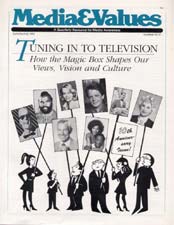We Are What We Watch: We Watch What We Are
|
This article originally appeared in Issue# 40-41
|
New research study explores WHY we watch and WHAT we choose.
Why do we watch television?
Perhaps in one sense, because it is there. But analysts have long speculated on the appeal of various program categories, and advertisers and programmers have invested millions of dollars in attempts to reach audience segments of a particular age, sex or income level.
Most of these efforts have focused on answering the question, "Who tunes in?" But a groundbreaking research effort by marketing experts Ronald Frank and Marshall Greenburg has gone beyond the demographic categories to focus on how television viewing fits in with other leisure time decisions including other media choices like movies, magazines, newspapers and sports events.
By establishing a connection between viewing habits and other interests Frank / Greenberg have helped to answer a very different question: "How do television programs fit in with what viewers need?" To put it another way, we are indeed what we watch. And we watch what we are.
As reported in their report of their groundbreaking study, The Public's Use of Television, the two researchers utilized over 2,400 personal interviews and analysis techniques culled from marketing and sociology to identify some of the reasons people use TV and how it can help to fulfill unmet needs.
The result is a psychological profile of 14 categories of viewers — or media types — whose viewing habits were correlated with their interests.
Even a casual look at the categories explodes some common assumptions. For example: Young, blue-collar men watch TV sports less frequently than any other group.  Black viewers watch more television but also read the highest percentage of publications. Teenage boys like programs that poke fun at male authority figures.
Black viewers watch more television but also read the highest percentage of publications. Teenage boys like programs that poke fun at male authority figures.
Although roughly divided by age and sex, the media typecasting charted here betrays the strengths, weaknesses and enthusiasms that go to make individual viewers more than a number on a rating card. Even more significantly, as the research shows, TV is not the primary medium for many viewers, and they use a mixture of media to satisfy their information and entertainment needs.
MEN
- Mechanics and Outdoor: Primarily young and blue-collar, they prefer non-competitive physical activities that satisfy a need for individual accomplishment — like auto repair, camping, fishing over television. Adventure, science fiction, and crime programming satisfy their need for escape. But they rarely watch intellectual or sports broadcasts. Heavy users of magazines that complement personal interests and hobbies, 'how-to' and escape-related books, science fiction and honor films.
- Money/Nature's Product: Usually older males interested in more passive activities yielding some soil of return or product, and seeking more interpersonal contact and support, including an above-average concentration of rural retirees. Moderate viewing focuses on nature programs, money and business, current events and trends in the world around them. Traditional American values. Light use of the other media concentrates on business, real estate, and travel sections of the newspaper, and books and movies that feature strong male characters.
- Family and Community-Centered: Blue and white-collar males, especially from areas outside the major metropolitan areas. Their many family, community and religious interests leave little time for television. Generally prefer religious, news and sports programs. However, newspapers are best suited to breadth and depth of their interests.
WOMEN
- Elderly: Whether retired, widowed, or with grown children, they rely on television to satisfy their needs for a sense of belonging in the absence of interpersonal contact. Favorite programs include dramas, game shows, soap operas and religious broadcasts, with light to moderate use of most other media.
- Arts and Cultural: Mostly highly educated women belonging to households headed by managers or professionals, and with strong needs for intellectual stimulation and growth. Watch mostly theatrical and musical performances (especially classical), documentaries and news. However, they prefer all print media to television.
- Home and Community-Centered: High percentage of married homemakers, who are far more interested in sound family ties and local community events. Below-average viewing time, strongly favor soap operas and religious broadcasts. Above-average consumers of publications centered on women's interests and issues.
- Family Centered: Women with young children and interests in family interaction and child development activities use television as a vehicle for bringing children and adults together. Tailor viewing to what their children either want to or should watch, favoring non-violent, family-oriented dramas and movies, especially educational children's broadcasts. This group also makes great use of women's service and home magazines, and psychology or self-help books.
YOUTH
- Competitive Sports and Science Engineering: Teen-age males with a strong need for intellectual stimulation, status enhancement and escape from boredom. Moderate television consumers, but heavy viewers of program types with strong male personalities or that mock traditional authority figures. They tend to reject television fare that is intellectually up-scaled or abstract, features assertive females or downplays the need for personal independence. Read large quantities of sports, automotive and mechanics magazines, and use books and movies for escape.
- Athletic and Social Activities: Teenage females from upper-income families with high need to escape from problems at home and to be socially stimulating. Although below-average overall television viewers, they show a strong interest in escapist programming involving male/ female relationships in non-family, lighthearted situations. Intermediate usage of magazines is similarly oriented toward women's services, romance and fashion. Also avid consumers of escapist books and movies about love and romance, as well as the radio.
- Indoor Games and Social Activities: Low-income females interested primarily in indoor games and other non-intellectual means to higher status and social stimulation. Heavy television watchers, their preferred programming is youth and youth homemaker-oriented; virtually no viewing time devoted to informational or cultural programming. They also read an above-average share of magazines. Surprisingly. their book and movie consumption is somewhat more intellectual and less escapist than for other youth-concentration segments.
MIXED (Mainly Adults)
- News and Information: Most interested in keeping informed on a broad range of subjects and in being socially stimulating. Devote the most time to watching television: news, talk shows, variety shows, documentaries, movies and sports. Light users of non-print media.
- Detached: Low socio-economic profile coincides with few psychological needs to satisfy, leading to very light usage of all media. Television preferences are somewhat escapist-oriented, with an emphasis on crime dramas, movies, science fiction and soap operas.
- Cosmopolitan Self-Enrichment: Extremely high socio-economic profile and diverse pattern of intellectual and cultural interests leads to a tremendous need for intellectual stimulation. The lightest of all television viewers, but also the most discriminating, they systematically avoid escape and general entertainment-oriented programs. Voracious readers of all print media, especially books and news and financial publications, they prefer films with a high intellectual content.
- Highly Diversified: Disproportionately black and Southern. These viewers compensate for their lack of educational and social advantages by watching more television than any other group except for viewers in the News and Information media type. Their magazine readership, especially of black publications, is the highest of all categories. Above-average use of local newspapers, general-interest radio, and films that interest all family members.



